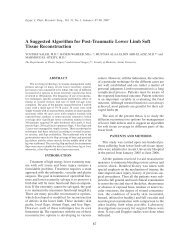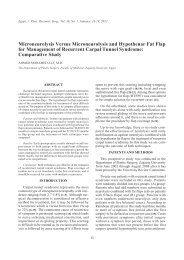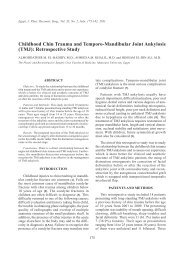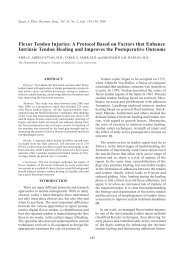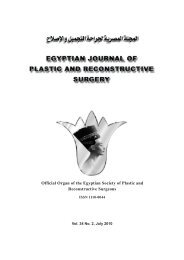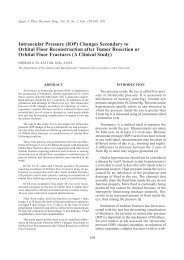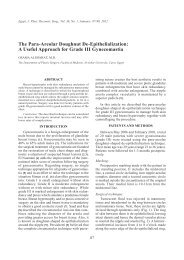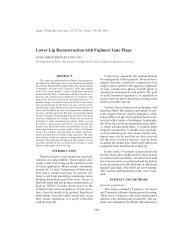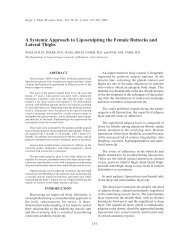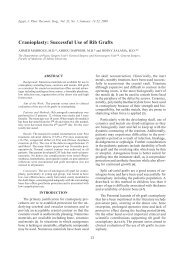Vermillion Notch After Millard Repair of Unilateral Cleft Lip - ESPRS
Vermillion Notch After Millard Repair of Unilateral Cleft Lip - ESPRS
Vermillion Notch After Millard Repair of Unilateral Cleft Lip - ESPRS
You also want an ePaper? Increase the reach of your titles
YUMPU automatically turns print PDFs into web optimized ePapers that Google loves.
282 Vol. 33, No. 2 / <strong>Vermillion</strong> <strong>Notch</strong> <strong>After</strong> <strong>Millard</strong> <strong>Repair</strong> <strong>of</strong> <strong>Unilateral</strong> <strong>Cleft</strong> <strong>Lip</strong><br />
DISCUSSION<br />
A smooth balanced vermillion is the resultant<br />
<strong>of</strong> a perfect match between the medial and lateral<br />
segments. <strong>Vermillion</strong> notching represents an element<br />
<strong>of</strong> mismatch between the two segments. The<br />
problem <strong>of</strong> vermillion mismatching may result<br />
from indolent factors in the cleft lip, surgical factors<br />
related to the technique used or a combination <strong>of</strong><br />
both [4].<br />
By indolent factors, we mean obvious difference<br />
in bulk between the medial and lateral lip<br />
segments caused by the mechanism <strong>of</strong> clefting and<br />
in particular the oblique muscle orientation. While<br />
some surgeons described a hypoplastic medial lip<br />
segment, others stated the opposite. Mulliken<br />
reported his 15-year experience with the <strong>Millard</strong><br />
technique in correction <strong>of</strong> unilateral cleft lip. He<br />
stated that the most common secondary labial<br />
problem was fullness <strong>of</strong> the lateral mucosal border<br />
and minor deficiency <strong>of</strong> the median tubercle. He<br />
also mentioned that although this imbalance could<br />
be addressed primarily, it is probably best corrected<br />
secondarily. This is accomplished by rotation <strong>of</strong><br />
a de-epithelialized submucosal flap into the tubercle<br />
[4]. The same principle <strong>of</strong> hypoplastic medial<br />
segment was described by Noordh<strong>of</strong>f. However,<br />
he advocated the use <strong>of</strong> a triangular vermillion<br />
flap devised from the redundant vermillion on the<br />
lateral side to compensate for its deficient counterpart<br />
on the medial side [6]. In this study group,<br />
only 2 patients had evident hypoplastic medial<br />
segments.<br />
On the other hand, <strong>Millard</strong> stated that many <strong>of</strong><br />
his patients exhibit the opposite problem. He referred<br />
to attenuation <strong>of</strong> the lateral mucosal free<br />
margin. For this deficiency <strong>of</strong> the lateral mucosa,<br />
he recommends secondary correction with a V-Y<br />
mucosal roll-down flap [1]. In the same line, Lewis<br />
also described the problem as a full medial segment<br />
as opposed to an attenuated lateral segment. However,<br />
he referred to excessive advancement <strong>of</strong> the<br />
lateral flap as a cause <strong>of</strong> the imbalance rather than<br />
indolent factors [7].<br />
Indolent factors can therefore be responsible<br />
for vermillion mismatch. However, surgical factors<br />
can be as much influential. Surgical inadequacy<br />
can be evident in muscle restoration at the lower<br />
part <strong>of</strong> the lip, in medial flap rotation or in lateral<br />
flap advancement. The aberrant, oblique configuration<br />
<strong>of</strong> the orbicularis muscle segments represents<br />
one <strong>of</strong> the most important anatomic abnormalities<br />
in the cleft lip. Correct repositioning <strong>of</strong> the muscle<br />
into a horizontal orientation is critical in repair.<br />
Success on the skin level will never compensate<br />
for deficiencies in muscles redirection [8].<br />
This is particularly applicable to the lower half<br />
<strong>of</strong> the lip, where the obliquity <strong>of</strong> the fibers may<br />
account for its deficiency. Deficiency <strong>of</strong> the muscle<br />
bulk can cause vermillion notching. It is the muscle<br />
bulk on the medial segment that is usually less<br />
than its counterpart on the lateral segment. Adequate<br />
dissection and reorientation <strong>of</strong> the muscle fibers<br />
is crucial in obtaining a matched vermillion [9].<br />
An overdo in muscle approximation has been proposed<br />
by Narayanan, producing a ''roll'' or ''sausage''<br />
bulge at the site <strong>of</strong> muscle repair in order to achieve<br />
enough bulk at the vermillion border capable <strong>of</strong><br />
preventing notching [3]. All cases included in this<br />
study were found to have inadequate muscle bulk<br />
at the lower border <strong>of</strong> the lip. Muscle dissection<br />
and approximation was a common step in all corrective<br />
procedures (Fig. 1).<br />
Regarding the medial flap, Ray stated that one<br />
<strong>of</strong> the more common errors observed in <strong>Millard</strong>’s<br />
technique is insufficient rotation. He described<br />
several rotation errors that include faults in flap<br />
incision design, failure to utilize a back cut and<br />
failure to orient the muscle fibers. The effect <strong>of</strong><br />
under rotation <strong>of</strong> the medial flap was emphasized<br />
by Narayanan as a definite cause <strong>of</strong> vermillion<br />
notching. In this series, 75% <strong>of</strong> patients had inadequate<br />
rotation <strong>of</strong> the medial segment. Increasing<br />
rotation was achieved by total revision <strong>of</strong> the lip,<br />
with back cuts at the columellar base for more<br />
length.<br />
Retaining effective rotation also depends on<br />
appropriate design and elevation <strong>of</strong> the advancement<br />
flap. A critical determinant is where the<br />
advancement flap is pared (<strong>Millard</strong> point 8). The<br />
classic technique in defining this point depends<br />
on measuring the non cleft vermillion from commissure<br />
to Cupid’s bow peak and imposing this<br />
measurement on the cleft side [1]. Other surgeons<br />
define this point by the point where the white roll<br />
attenuates. Both these techniques put the paring<br />
point too medial on the vermillion-cutaneous junction<br />
<strong>of</strong> the cleft side, with consequent shortening<br />
<strong>of</strong> the lip height and possible notching [10].<br />
Ray recommended using the volume <strong>of</strong> the<br />
vermillion in determining the paring point. It is<br />
the point where the vermillion volume starts to<br />
attenuate that would obtain perfect matching.<br />
Such lateral placement <strong>of</strong> the paring point may<br />
apparently sacrifice too much vermillion on the




